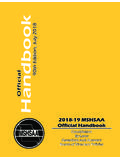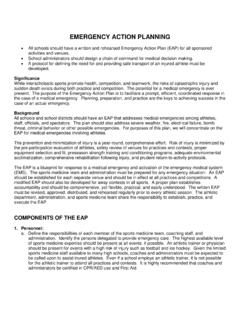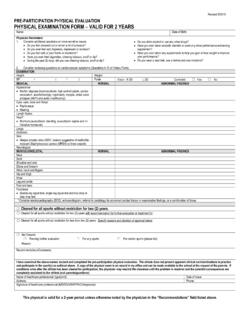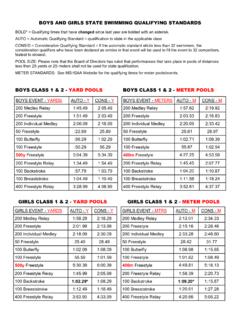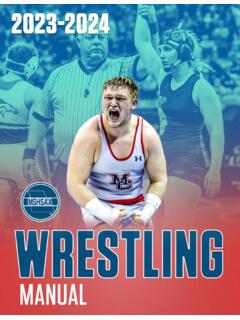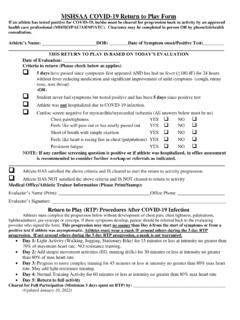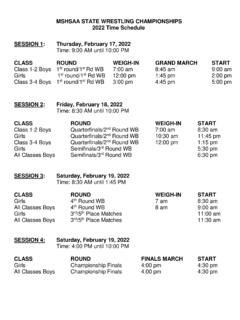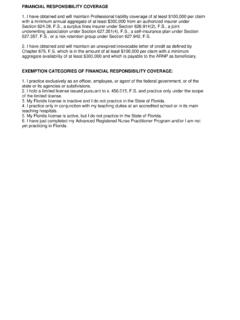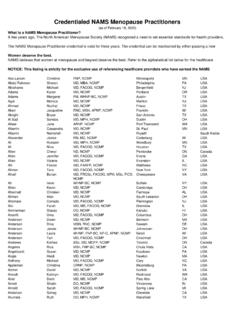Transcription of MSHSAA Concussion Return to Play Form
1 MSHSAA Concussion Return to Play Form This form is adapted from the Acute Concussion Evaluation (ACE) care plan on the CDC website ( ). All medical providers are encouraged to review this site if they have questions regarding the latest information on the evaluation and care of the scholastic athlete following a Concussion injury. Please initial any recommendations that you select below. Athlete s Name: Date of Birth: Date of Injury: THIS Return TO PLAY IS BASED ON TODAY S EVALUATION Date of Evaluation: Care Plan Completed By: Return to This Office (Date/Time): Return to School On (Date): Return TO SPORTS The following are the Return to sports recommendations at the present time: Physical Education: Do NOT Return to PE class at this time. May Return to PE class at this time.
2 Sports: Do NOT Return to sports practice or competition at this time. May gradually Return to sports practices under the supervision of the healthcare provider for your school or team. May be advanced back to competition after phone conversation with attending physician (MD/DO/PAC/LAT/ARNP/Neurophysiologist) Must Return to physician (MD/DO/PAC/LAT/ARNP/Neurophysiologist) for final clearance to Return to competition. - OR - Cleared for full participation in all activities and restrictions. Return of symptoms should result in re-evaluation by physician (MD/DO/PAC/LAT/ARNP/Neurophysiologist) for assessment. Medical Office Information (Please Print/Stamp): Evaluator s Name: Office Phone: Evaluator s Signature: Evaluator s Address: should not Return to practice or play for at least 24 hours after their head injury has occurred.
3 2. Athletes should never Return to play or practice if they still have ANY symptoms. 3. Athletes: Be sure that your coach and/or athletic trainer are aware of your injury and symptoms, and that they have the contact information for the treating physician. PLEASE NOTE: Return to Play (RTP) Procedures After a Concussion 1. Return to activity and play is a medical decision. The athlete must meet all of the following criteria in order to progress to activity: Asymptomatic at rest and with exertion (including mental exertion in school) AND have written clearance from their primary care provider or Concussion specialist (athlete must be cleared for progression to activity by a physician other than an Emergency Room physician, if diagnosed with a Concussion ). 2. Once the above criteria are met, the athlete will be progressed back to full activity following the step-wise process detailed below.
4 (This progression must be closely supervised by a Certified Athletic Trainer. If your school does not have an athletic trainer, then the coach must have a very specific plan to follow as directed by the athlete s physician). 3. Progression is individualized, and will be determined on a case by case basis. Factors that may affect the rate of progression include: previous history of Concussion , duration and type of symptoms, age of the athlete, and sport/activity in which the athlete participates. An athlete with a prior history of Concussion , one who has had an extended duration of symptoms, or one who is participating in a collision or contact sport may be progressed more slowly. 4. Stepwise progression as described below: Step 1: Complete cognitive rest. This may include staying home from school or limiting school hours (and studying) for several days.
5 Activities requiring concentration and attention may worsen symptoms and delay recovery. Step 2: Return to school full-time. Step 3: Light exercise. This step cannot begin until the athlete is no longer having Concussion symptoms and is cleared by a physician for further activity. At this point the athlete may begin walking or riding an exercise bike. No weight-lifting. Step 4: Running in the gym or on the field. No helmet or other equipment. Step 5: Non-contact training drills in full equipment. Weight-training can begin. Step 6: Full contact practice or training. Step 7: Play in game. Must be cleared by physician before returning to play. The athlete should spend 1 to 2 days at each step before advancing to the next. If post- Concussion symptoms occur at any step, the athlete must stop the activity and the treating physician must be contacted.
6 Depending upon the specific type and severity of the symptoms, the athlete may be told to rest for 24 hours and then resume activity at a level one step below where he or she was at when the symptoms occurred.

